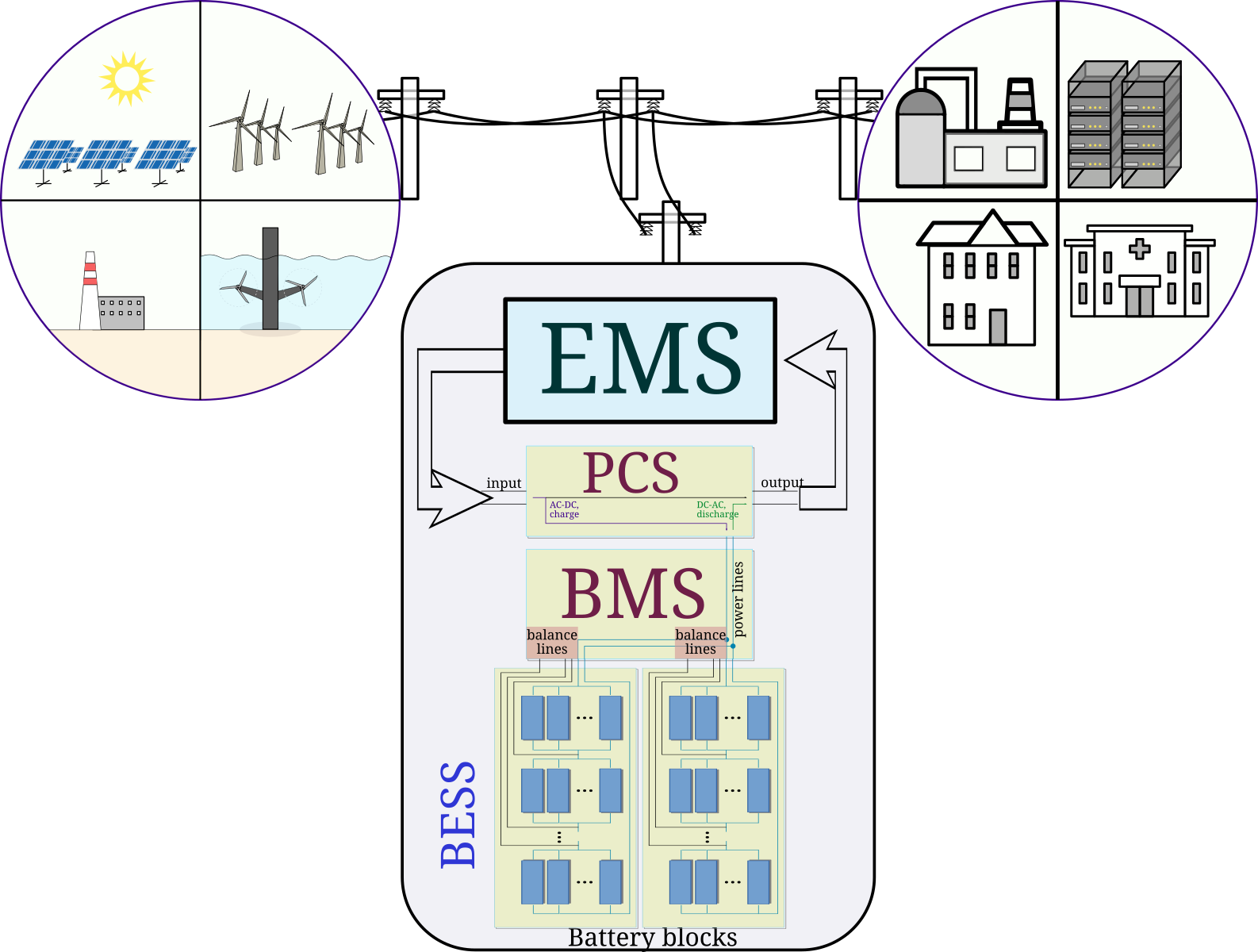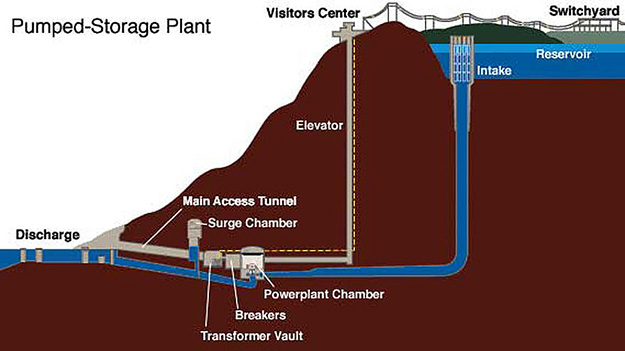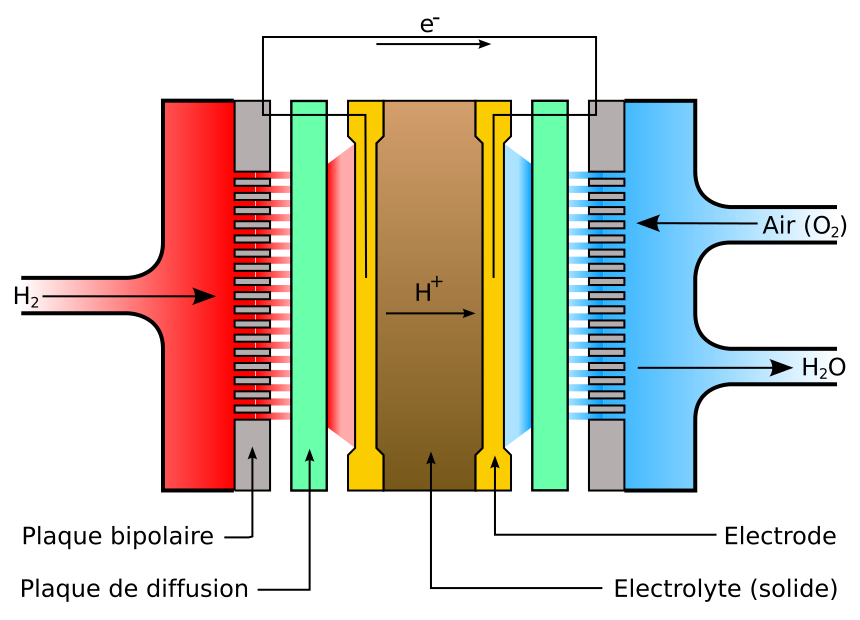IB Syllabus focus:
‘Intermittent sources need storage for reliability and peak-shaving: batteries, pumped hydro, fuel cells, and thermal storage are options.’
Storage systems for intermittent renewables are critical for ensuring stable and reliable electricity supply, balancing fluctuations, and supporting sustainability in modern energy systems worldwide.
Why Storage is Needed
Renewable energy sources such as solar and wind are classified as intermittent because their output depends on natural conditions that fluctuate across hours, days, and seasons. Intermittency causes challenges such as mismatches between energy supply and demand. For example, peak electricity demand may occur in the evening, but solar energy output drops after sunset.
To maintain reliability, energy storage smooths out these fluctuations by:
Storing surplus energy when production exceeds demand.
Releasing energy during shortages or high demand periods.
Stabilising frequency and voltage in power grids.
Intermittent energy source: An energy supply that is not continuously available due to external factors such as weather or time of day.
Without effective storage, reliance on intermittent renewables risks blackouts, reduced energy security, and diminished public trust in renewable technologies.
Key Storage Technologies
Batteries
Batteries store energy through chemical reactions and release it as electricity when needed.

Block diagram showing how a battery energy storage system interfaces with power sources and loads, with a simplified internal BESS block. This supports discussion of fast response and peak-shaving for intermittent renewables. Diagram focuses on system roles rather than chemistry, appropriate for ESS SL scope. Source.
Lithium-ion batteries dominate due to high energy density and declining costs.
Advantages: Quick response times, scalability, and suitability for decentralised systems (e.g., households with solar panels).
Disadvantages: Limited lifespans, environmental impacts from mining lithium, cobalt, and nickel, and disposal challenges.
Battery: A device that stores chemical energy and converts it into electrical energy when discharged.
Pumped Hydro Storage
This method uses two water reservoirs at different elevations. During low demand, electricity pumps water to the upper reservoir. When demand is high, water is released to the lower reservoir through turbines, generating electricity.

Cross-sectional schematic of a pumped-storage hydro facility showing upper reservoir, intake, underground powerplant chamber with pump-turbines, and lower discharge. Labels also include site features such as a surge chamber and switchyard; these are helpful context but not required by the syllabus. The diagram highlights how water is pumped uphill off-peak and released through turbines at peak to provide reliable power. Source.
Advantages: Large-scale capacity, long operational lifespan, and efficiency around 70–80%.
Disadvantages: Requires specific geography, can disrupt ecosystems, and has high upfront construction costs.
Fuel Cells and Hydrogen
Fuel cells generate electricity by combining hydrogen with oxygen, producing only water as a by-product. Hydrogen itself can be produced using surplus renewable energy through electrolysis, making it a form of long-term energy storage.

Diagram of a PEM fuel cell indicating hydrogen oxidation at the anode, proton transport across the membrane, and oxygen reduction at the cathode to form water and heat. This visual reinforces the role of fuel cells as a storage-conversion option for renewables. Some symbol styling is generic but all labels needed for ESS SL are present. Source.
Advantages: Clean emissions, scalable, and useful for both electricity and transport sectors.
Disadvantages: Hydrogen production remains expensive, storage is technically challenging, and distribution infrastructure is underdeveloped.
Thermal Storage
Thermal energy storage captures heat or cold for later use. For electricity, this is often linked to concentrated solar power plants, where mirrors focus sunlight to heat a fluid, which can later produce steam to drive turbines.
Advantages: Allows solar plants to produce electricity after sunset, relatively low-cost for some applications.
Disadvantages: Heat losses over time and limitations to specific energy systems.
Balancing Reliability and Peak-Shaving
Energy storage ensures reliability by compensating for sudden drops in generation. It also supports peak-shaving, where stored energy is released during times of high demand, reducing strain on grids and cutting the need for expensive backup fossil fuels.
Peak-shaving: The process of using stored energy to reduce electricity demand during peak consumption periods.
By levelling demand, storage improves efficiency and reduces carbon emissions from backup generation.
Environmental and Societal Considerations
Storage technologies, while supporting renewables, carry their own environmental and societal implications.
Resource extraction: Mining of lithium, cobalt, and rare earths causes pollution and raises justice concerns.
Land use: Pumped hydro may displace communities and wildlife.
Waste: Batteries create hazardous waste streams if not recycled properly.
Policymakers and engineers must weigh these impacts against the benefits of enabling more renewables.
Technological and Policy Drivers
The growth of storage technologies depends on multiple drivers:
Economic: Falling battery costs have accelerated adoption.
Technological: Advances in materials science improve efficiency and durability.
Political: Government incentives and international climate agreements encourage investment in storage.
Geographical: Nations with limited fossil reserves prioritise renewable storage solutions to secure energy independence.
Future Outlook
Hybrid storage systems: Combining batteries with pumped hydro or hydrogen could offer greater flexibility.
Grid integration: Smart grids will better coordinate storage with fluctuating supply and demand.
Circular economy: Recycling of batteries and reuse of materials will reduce environmental harms.
Ultimately, effective storage is central to a sustainable energy future, ensuring intermittent renewables can provide reliable, low-carbon electricity to societies worldwide.
FAQ
Short-term storage, such as lithium-ion batteries, provides rapid response and is used to smooth daily fluctuations in supply and demand.
Long-term storage, like hydrogen or pumped hydro, can hold energy for weeks or months. This type is critical for addressing seasonal variations in renewable output.
Power (MW) indicates how quickly storage can deliver electricity at a given moment.
Energy (MWh) reflects the total amount of electricity that can be stored and discharged over time.
Both measurements are important because a system may supply high power briefly or sustain lower power for extended periods.
Sudden drops in renewable generation can cause frequency imbalances.
Storage devices inject electricity within milliseconds, restoring balance.
Voltage fluctuations are corrected by discharging or absorbing reactive power.
This stabilisation prevents equipment damage and ensures consistent electricity quality.
It stores energy in the form of gravitational potential energy. Water is pumped to a higher elevation and later released through turbines to generate electricity.
This mimics charging and discharging a conventional battery but at a much larger scale, making it ideal for national grids.
Geography: Mountainous areas favour pumped hydro; flat regions often rely on batteries.
Economy: Nations with limited budgets may prioritise lower-cost thermal storage.
Policy: Government incentives can accelerate adoption of specific technologies.
Infrastructure: Existing grid systems determine which storage options can be integrated most effectively.
Practice Questions
Question 1 (2 marks)
Define the term peak-shaving and explain its importance in the context of energy storage for intermittent renewable sources.
Mark scheme:
1 mark: Correct definition of peak-shaving (the use of stored energy to reduce demand during peak consumption periods).
1 mark: Explanation of its importance (e.g., reduces strain on grids, improves reliability, or decreases reliance on backup fossil fuels).
Question 2 (5 marks)
Discuss two storage technologies that can support the reliability of intermittent renewable energy sources. In your answer, outline one advantage and one disadvantage for each technology.
Mark scheme:
1 mark: Identification of first relevant storage technology (e.g., batteries, pumped hydro, fuel cells, or thermal storage).
1 mark: Advantage of first technology (e.g., batteries respond quickly to demand changes).
1 mark: Disadvantage of first technology (e.g., resource-intensive and limited lifespan).
1 mark: Identification of second relevant storage technology.
1 mark: Either advantage or disadvantage correctly explained for second technology (maximum one mark if only one aspect is given).
(Full marks require two distinct technologies, with at least one advantage and one disadvantage correctly outlined for each.)

